|
Retreats and Relaxation, 1900s~Style
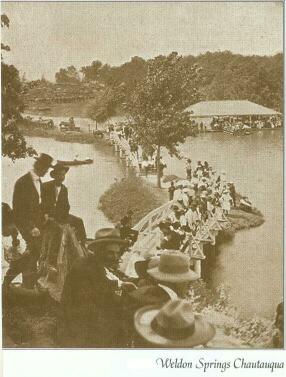
|
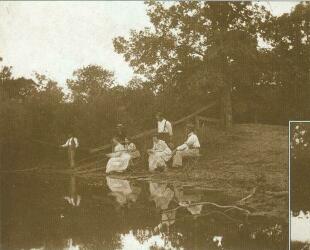 Family Outings
Family Outings
Touring, automobile camping and outdoor recreation in general were a way of life for the H.O. Moffet family of Macoupin County. They toured Illinois and other parts of the United States in two vehicles, savoring the great beauty of the country. They also fished as a family at their farm pond north of Modesto.
|
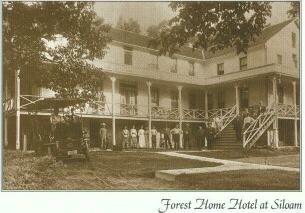
|
By the start of the 20th century, Illinois was making its presence known as one of the country's leading agricultural states, and its residents were seeking relaxation in the outdoors. One popular retreat was the Forest Home Hotel at Siloam. Patrons came from miles around to spend time at the huge white frame structure, enjoying the spring water, bath house and swimming pool. When the railroad bypassed Siloam, business began to decline and the town eventually folded in 1931. The old hotel was sold at auction and torn down after local citizens entered into an agreement with the State of Illinois in 1940 to develop what is now known as Siloam Springs State Park.
Chautauquas, like the 10-day event at Weldon Springs, were
extremely popular in the early 1900s. Many patrons purchased the $1.50 season tickets and tent camped for the entire time. Tent rental for the full 10-day period ranged from $2.50 for a 7 ft. x12 ft. wall tent to $9 for a 14 ft. x 24 ft., 5-room tent. Daily rentals also were available. Full-term renters also had access to such things as cots for 50 cents; chairs, 25 cents; camp stools, 15 cents; and gasoline torches, 50 cents. Programs were planned each day and included lectures, concerts, devotional exercises, sermons and entertainment. Fishing and boating were also popular activities at the site, which became a state park in 1955.
|
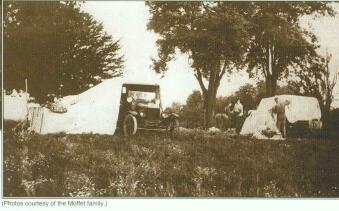
2 OutdoorIllinois
Hunting and fishing in the early 1900s
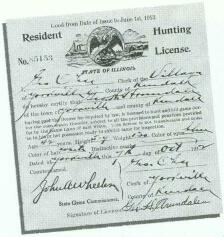
|
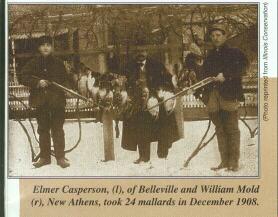
|
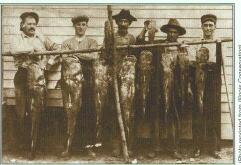
Several large flathead catfish were caught in the Kaskaskia River below New Athens in 1903. The largest weighed 67 pounds. L-R: Philip Gerhold, William Nold, Frank Hall, and Wendell Harschman, all of New Athens, and Elmer Casperson of Belleville.
|
|
Recollections
"Would you believe we could hire a surrey for
an all-day trip for $2? The driver would
the take us (15 miles ) to St. Peter's marsh on the Green River (south of Dixon). There, for $1 a day, you would get a room, food, a duck blind complete with live decoys, and if you had a good day, the proprietor would purchase the ducks you shot to sell to city restaurants. Mallards sold for 25 cents, pintails and green-winged teal for a dime, while blue-winged teal went for 15 cents. A box of 25 semi-smokeless shells cost 55 cents.
"Most hunters were sports. They never thought the day would come when there would be a scarcity of game. We used to shoot prairie chickens and pack them in barrels, salted down for food and sell them. Sometimes while sitting in a duck blind along a marsh, flocks of chickens would fly over-hundreds of them. Whoever thought they'd just about disappear from the state."
— Condensed recollections of Ed Rafter as told to Murray Crowder,
"The Golden Years," Outdoors in Illinois, 1955
|
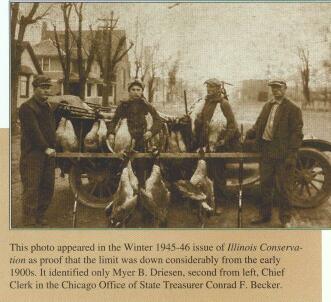
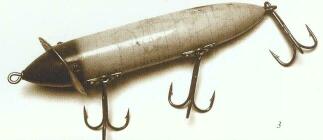
December 1999 3
1900-1929
|
As the century began, the U.S. Supreme Court had ruled in 1896 that the states, not private landowners, owned wildlife, giving states the right to protect wildlife living on both public and private land. The Illinois Game Commission was newly established and operational, and the state's first game warden had been hired. The 1900 Lacey Act made it illegal to transport live or dead wild animals, or their parts, across state borders without a federal permit. It was illegal to import foreign wildlife without a government merit permit. The first National Audubon Society Christmas bird census was conducted, and a moratorium was in place on hunting white-tailed deer in Illinois. Commercial fishermen were shipping thousands of tons of carp to eastern markets following the Illinois Fish Commision's introduction of the German carp into the Illinois River in 1893.
1903-Resident and non-resident hunting licenses required. It became illegal to sell waterfowl killed in Illinois. First-ever limit on ducks set at 100 birds per day. First federal wildlife refuge established at Pelican Island, Fla (Today there are more than 500.)
1904-Office of State Game Commissioner created, salary, $2,500 per annum. Ten game wardens authorized, salary, $75 per month. Several thousand bobwhite quail were imported from south and distributed throughout state. First state-operated game farm in nation established at Auburn.
1905-Duck limit lowered to 50 birds a day, irritating hunters.
1906-Duck limit further reduced to 35 birds day, making it hardly worthwhile to go hunting, according to some sportsmen.
1907-License required for the use of nets for seining purposes. Fur-taking season established.
1909-State law enacted making it illegal to bait ducks.
1911-Nonresident hook and line fishing license required.
1913-First fish hatcheries established at Spring Grove and Havana. Fish Commission and the Game Commission combined.
1914-Passenger pigeon was extinct.
1915-Game and Fish Commission purchased special state fish car to distribute fish from hatcheries via railroads.
1918-Migratory Bird Treaty Act implemented for protection of migratory birds.
1923-Illinois required first resident hook and line fishing licenses with monies being deposited into a special Fish and Game Fund.
1925-Illinois Department of Conservation established.
1927-State began to purchase land around Horseshoe Lake, Alexander County, to establish first wildlife refuge in Illinois.
1928-Law enforcement added to Department of Conservation.
1929-Beaver reintroduction began in state.
|
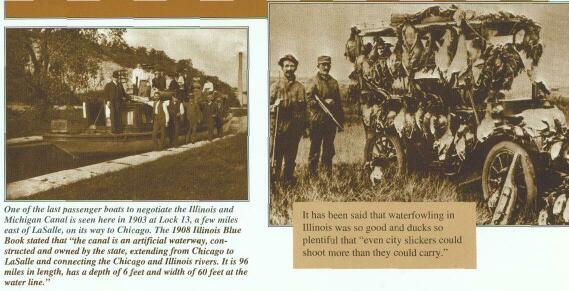
|
Illinois Worst Mine Disaster
The 1909 cherry Mine disaster killed 259 miners. It was the worst mine disaster in Illinois and the third worst in the country. It prompted the 1910 establishment of three mine rescue stations at LaSalle, Springfield and Benton. Each station cost approximately $9,000. The purposes of the rescue stations were to furnish a trained corps of men to assist in rescue efforts at mine sites in the event of an accident or disaster, and to train men in the use of rescue appliances so that ultimately every mine in the state would have a team of men who could enter. Illinois was the first state to provide statewide rescue teams and facilities.
|
4 OutdoorIllinois
1900-1929
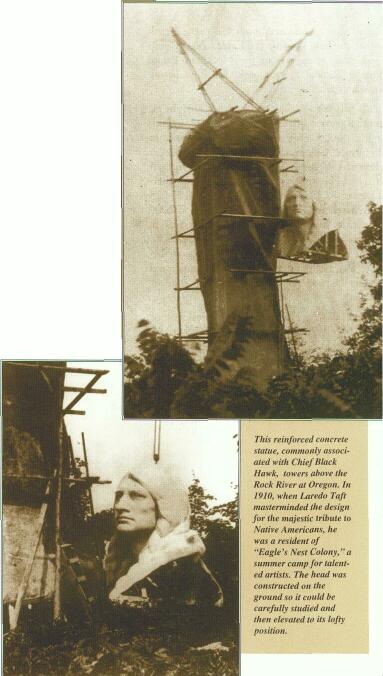
|
Where there's a will, there's a way
When Laredo Taft conceived the idea to create a monumental statue to honor the Native American Indian, legend had it the spot he selected was a favorite haunt of Chief Black Hawk. Taft created a 6-foot model of the statue and relied upon John Prashun for the engineering. Prashun, a young engineer experienced in concrete work, constructed a vast framework of lath, chicken wire and burlap seven times the size of the working model. Hollow cast plaster sections were then hoisted and fastened into place on a reinforced timber frame, and the gigantic head was cast full-size and lifted into position above a 3-foot wide hollow tube through the center of the structure.
An 18-foot-square concrete base was cast prior to the onset of cold weather. By November 1910, all was ready, and it was decided to continue through the winter. The cavernous interior received a spray of paraffin and clay water to prevent the mold from slicking. Two tons of steel rod were built into the interior to support the massive head and to reinforce the concrete.
An account of the following weeks reported uncooperative weather. "Water for casting had to be pumped up from the river below, and a heating system improvised to prevent its freezing. A vast canvas was stretched around the entire
scaffold to protect it and the workers from the cold and wind.
"Once the casting was begun, it had to continue uninterruptedly until complete or the whole effort would fail... Casting started on December 20. The temperature on the bluff dropped to two below zero. Two crews of 14 men each worked around the clock in frigid weather for 10 days and nights, until the vast hollow was filled to the top on Dec. 30, 1910. lt was calculated that 6,500 gallons of water, 412 barrels of Portland Cement, 2 tons of steel rods, 200 yards of burlap and 10 tons of plaster went into the statue. Completed, it stands 42 feet above the base and weighs somewhere near 268 tons."
The statue was dedicated on July 1, 1911. Today it serves as a landmark at
Lowden State Park, Oregon.
|
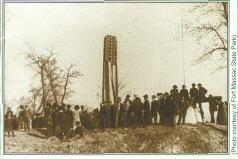
|
Twenty-four acres on the Illinois shore of the Ohio River at Metropolis were purchased through the efforts of the Daughters of the American Revolution in 1903 as the site for Illinois' first state park. Fort Massac State Park and a monument to George Rogers dark were dedicated May 5, 1908. dark was a Revolutionary War colonel who led his "Long Knives" regiment into Illinois at Massac Creek. He was able to capture Kaskaskia, 100 miles to the north, without firing a shot, thus taking the entire Illinois Territory for the State of Virginia and the fledgling United States.
|
December 1999 5
1930—1949
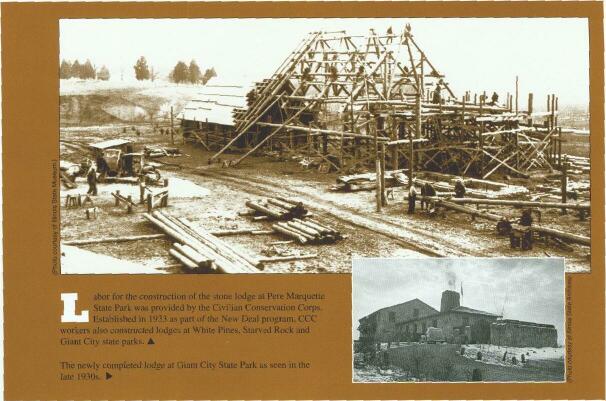
|
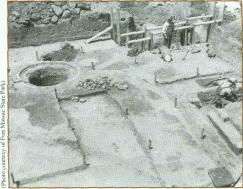
Works Progress Administration workers engaged in archeological work in 1941 at the original 18th century French fort site at Fort Massac State Park, Metropolis. The 1935 federal WPA program provided employment for 8.5 million persons, or one-third of the nation's jobless individuals. Although archeological and historical excavations were conducted on the site from 1939-42 and attempted again in 1966 and 1970, actual reconstruction of the 18th century structure was not begun until 1971.
|
1932—There existed an appetite for picturesque recreational settings, and the need for lodges and cabins was articulated in the first comprehensive plan for the state park system.
1933—The New Deal Program's Civilian Conservation Corps was created, and 500,000 unemployed young men were hired to plant trees, develop parks and recreation areas, restore silted waterways, provide flood control, control soil erosion, protect wildlife and carry out other conservation projects. Construction labor for state park lodges and cabins was furnished by the CCC, and eventually more than 77 CCC camps operated in Illinois. A worker was paid $30 a month, of which $25 was sent to his family. Room board, clothing and tools were provided by the government. The CCC disbanded in July 1942.
1933—Aldo Leopold of the University of Wisconsin became America's first professor of game management and published a textbook, Game Management. Leopold's game management creed: '...game is a crop, which nature will grow and grow abundantly, provided only we furnish the seed and a suitable environment.'
1936—CCC workers had completed construction of most of the buildings at Pere Marquette, Giant City, White Pines, Starved Rock and Giant City state parks.
1937—The Federal Aid in Wildlife Restoration Act (or Pittman-Robertson Act) levied a federal tax on all sales of guns and ammunition; an 11-percent excise tax with money returned to states based on the number of licensed hunters and the size of the state. Funds were to be used for hunter safety education programs, land acquisition and research. The Act also provided federal aid to states for management and restoration of wildlife.
|
6 OutdoorIllinois
1930—1949
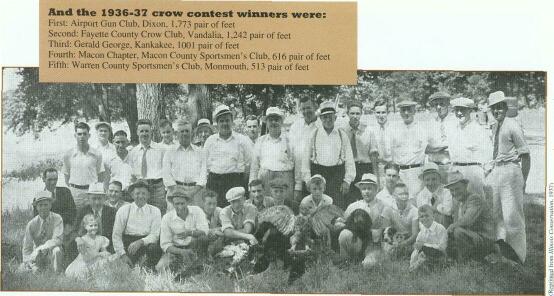
Something to Crow About
Airport Gun Club, Dixon, took first place in the Department of Conservation's 1936-37 crow season contest by submitting 1,773 pair of crow feet to the department. Hunting for the pesky crow remained a popular sport for years, and reduction in the number of crows was credited with increasing in the numbers of migratory waterfowl in Canada. (Reprinted from Illinois Conservation, 1937).
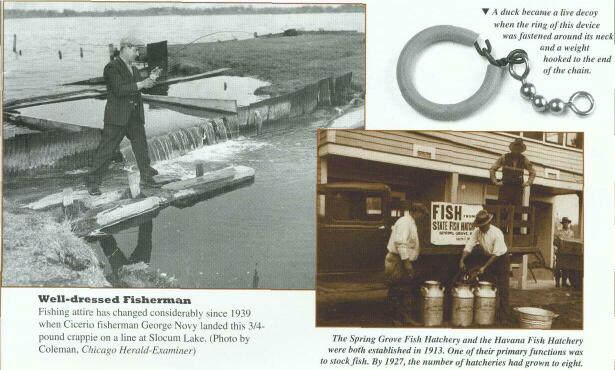
December 1999 7
1930—1949
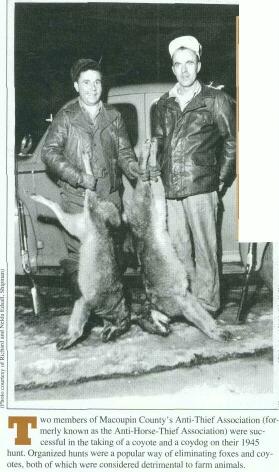
|
OutFoxed
"Members of the Downers Grove Sportsman's league, disappointed by the lack of good hunting the past few years, resolved to improve the situation by ridding the county of game's worst enemy, the red fox. Skipper, a sad-eyed fox hound was purchased to start the ball rolling.
"On December 30. several members who can't find the energy to shovel the snow off their walks were out at daylight to inaugurate the extermination campaign. Within a short time. Skipper picked up the scent of Brother Reynard and pressed him hard for almost 2 miles, causing him to hole up in the first available den. Short-winded sportsmen arriving some time later, found Skipper standing guard and haying happily.
"A length of barbed wire inserted into the den brought forth, not the fox, but a very indignant skunk, who expressed his discontent by spraying the area with his own particular brand of eau de cologne. The second attempt was more successful, and the fox was dispatched."
—Reprinted from Illinois Conservation, Winter 1945-46
|
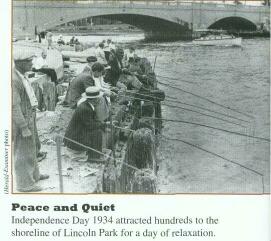
|
"Fox drives were organized and held to eliminate as many foxes as possible. Men would gather to take part in the drive and, for many, it was a sport. The men, many armed with shotguns (rifles were not allowed as they were too dangerous), would line up several hundred feet apart around one or two square miles and, upon signal, would all proceed forward. The foxes, upon scenting and seeing man, would flee inward until all would be driven and surrounded where those sporting shotguns could take aim and eliminate the escaping foxes."
- Jim Frank, Plainview
|
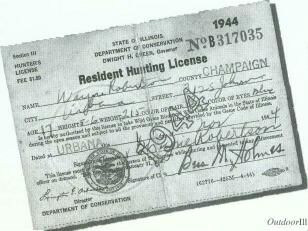
8 OutdoorIllinois
1930—1949
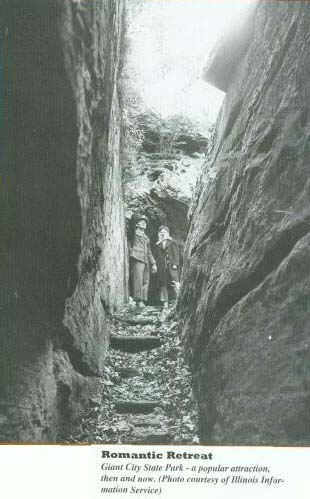
|
Remember When Wildlife Went to War?
Dateline 1943
•Waterfowl feathers were needed for lining military sleeping bags and for garments used by high-altitude fliers. Illinois' waterfowl harvest alone was enough to make 10,000 sleeping bags or line 2,500 garments.
•The War Production Board was asking for animal fats to furnish the glycerin essential for the manufacture of explosives. Housewives and restaurants were asked to save kitchen fats and to contribute the surplus for this purpose. It was estimated that glycerin obtainable from Illinois hunters and trappers would furnish explosives for 3 million anti-aircraft shells or 1.8 million anti-tank shells or 975,000 pounds of gunpowder.
The winter 1943 issue of Illinois Conservation contained several pages of information for the guidance of Illinois hunters and trappers who were willing to contribute to the war effort. Recipes also were published for the utilization of the game meat and included instructions for muskrat with wine sauce, roast opossum and opossum stuffing, groundhog (baked and fried) and skunk. (The magazine staff noted that it did not guarantee any of the recipes. It did advise that young animals be used whenever possible as older animals were often said to be tough with too much of a game taste.)
|
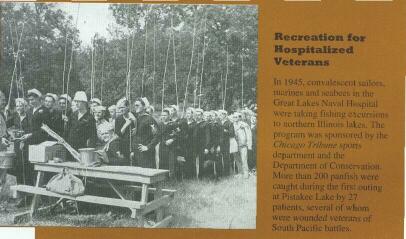
|
|
|
January 1937 - "The Ohio River at Shawneetown was up to flood stage. At that time, no one realized the Ohio Valley was in tor the greatest flood in recorded history, one that would result in property damages in excess of $75 million in this state and cost an estimated 466 lives in the watershed... More than 700,000 people were forced to evacuate their homes in the Ohio Valley... In Illinois alone, an army of 160,000 WPA workers toiled through the freezing weather, around the clock, in mud and rain, in a battle against the rising coffee waters of the Ohio." -Judith Joy, Illinois, November 1977
|
December 1999 9
1950—1979
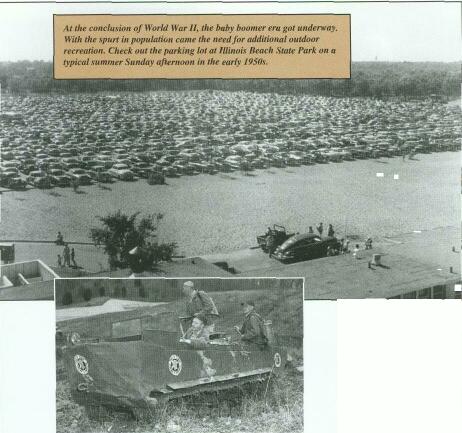
The 1950s was the decade of lake building. The Department was operating just 14 public fishing areas in 1950. In 1954, the 40-acre Red Hills Lake in Lawrence County was the first to be constructed using Dingell-Johnson tax dollars, followed by Argyle Lake and Lake Murphysboro. Fishing was cheap entertainment. A resident license was only $1, while non-residents could fish for $2.
|
|
State parks and memorials were transferred
to the Department of Conservation in 1951, giving the agency new direction. The emphasis was no longer just forestry, hunting and fishing.
It now included camping, hiking, nature trails and boating.
|
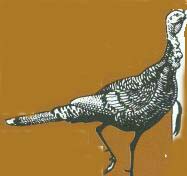
Wild turkeys through out the Prairie
State? Not likely. The wild turkey had been
absent from the state since the early part of the century.
Because these birds require extensive tracts of forest to survive, it was believed they would never
be numerous in IIlinois, and , probably not live at all in counties with less than 20-percent forest cover. But in the late 1950s. wildlife biologists look a chance. They released turkeys, first in the Shawnee National Forest, then in counties with lesser amounts of woodlands. And they quickly
live-and thrive-in counties with high
crop production. Today, wild turkeys are found in every county, and are hunted in more
than 80 counties.
|

To encourage the use of dogs when hunting waterfowl, the Federal duck stamp for 1959 featured a painting of King Buck, a black lab owned by John Olin from Alton's Nilo Kennels. Twice crowned a national champion. King Buck is the only dog to grace a federal duck stamp.
|
|
Deer were becoming commonplace in the 1950s. Biologists estimated the state had 2,550 deer in 1950, and by 1955, their survey indicated about 8,150 deer were living in 86 counties (the 1999 estimate is 700,000 deer). Farmers were coinplaining about the deer's appetite for corn and beans, and an estimated 200 deer were being killed annually by vehicles. Biologists believed it was time for deer hunting to return to the Prairie State, which it did in 1957. Thirty-three counties were three counties were opened to hunling, and 1.735 deer were taken.
|
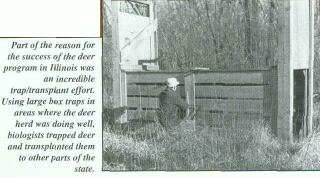
|
10 OutdoorIllinois
1950—1979
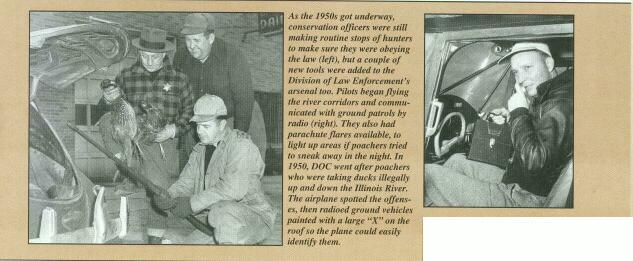
When the Edgewater Golf Course closed in Chicago, the land was up for grabs. Developers wanted to build high rises on the rolling land located at Western Avenue and Pratt Boulevard, while DOC thought the land could be better used for outdoor recreation. In 1969, DOC was able to purchase
52 acres of land for $7.9 million and renamed it Warren State Park. The Chicago Park District eventually purchased the remaining 40 acres several years later, and DOC's property was turned over to the city to be managed as a city park.
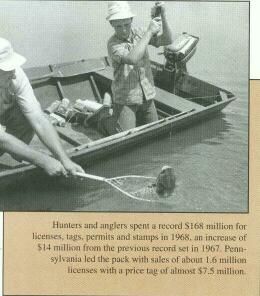
|
The Department of Conservation
was working with organizations to provide outdoor recreation for disabled veterans in the 1950s. The program began when a group of wheelchair-bound vets were taken to a farm near Richmond for a pheasant hunt in 1951. After a day of shooting, the veterans were treated with a game dinner.
The program was so successful it was copied by California and Pennsylvania the following year.
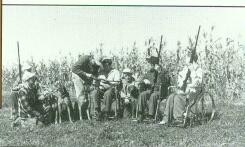
|
|
In 1962, Rachel Carson published the book that made a difference. Her Silent Spring alerted the public to the dangerous side effects pesticides were having on wildlife.
|

|
If the 1950s was the decade of small lakes, the 1960s was the decade of the big ones. Illinois' three major reservoirs-Carlyle, Shelbyville and Rend-were built during this decade. The photo at left shows construction of Carlyle Lake's gates. A historic first took place as the lakes were being constructed. DOC negotiated a partnership with the Corps of Engineers to manage some of the land and provide fisheries management at these sites. Since then, the agency has entered into a number of agreements to manage land with utilities and private areas.
|
December 1999 11
1950—1979

|
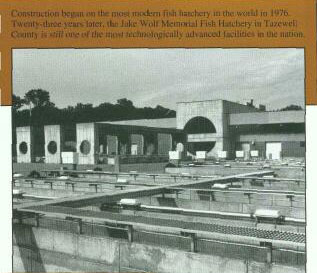
|
|
1971—The Illinois Scenic Rivers Act came into being to preserve rivers with scenic, recreational, geological, floral, faunal or historical values.
1972—Gov. Richard Oglivie proclaimed Sept. 23 as Illinois Hunting and Fishing Day. Illinois now has the largest celebration in the nation.
1975—A $5 state duck stamp was initiated to ensure long-term financing for flyways and breeding grounds. The monarch butterfly became the state insect.
1976—Gov. Dan Walker and Conservation Department Director Tony Dean planted a 'moon tree' on the Capitol grounds on Arbor Day. The young sycamore was one of 34 seedlings grown from seeds that had journeyed to the moon aboard Apollo 14 in 1971.
Illinois began a 3 1/2-year-long Natural Areas Inventory, the first of its magnitude in the nation. The computerized inventory produced a file on every significant natural area in the State-1,089 of them, nearly half of which were unknown prior to the search. The inventory enabled the state to develop a plan for acquiring and/or saving the areas, and reduced the potential of development or accidental destruction.
1977—Planners were studying Illinois Beach State Park to see if a harbor for a marina was feasible, leading to the construction of North Point Marina-the nation's largest inland marina. Scientists at the Illinois Natural History Survey were developing what they were calling a "super bass". The fish, which was being grown through cross-breeding, would take on characteristics that would appeal to Illinois anglers—it would be aggressive and fast-growing. Unfortunately, it was not to be. Scientists found it was so aggressive it would get caught so many times that it would never grow to any size.
1978—After a 35-year absence, a pair of bald eagles established a nest and raised two young in a
remote Alexander County location.
DOC was working to make properties more accessible for people with disabilities, a task that continues today.
1979—Hunters took nearly 19,700 deer during the six-day firearm hunt.
|
|
A 1975 study showed line average Illinois fishing trip cost $8.37. About 3/4 of that went toward food, transportation and lodging. The typical angler was 34 years old, earned about $15,300 a year and went fishing 22 times a year, resulting in 36.6 million fishing days. Two of every three anglers were males, and eight of every 10 were urbanites. Anglers spent $306 million in pursuit
of their pastime. The fish Illinoisans preferred to catch (in
order): catfish, largemouth and smallmouth bass, crappie, walleye and sunfish.
On a national scale, 44 million Americans spent a record $300 million on state hunting and fishing licenses in 1975, Illinois had 907,586 fishing licenses, tags and permits for $2.1 million in revenue, and 463,296 hunting licenses, tags, permits and stamps, bringing in $1.6 million in revenues.
|
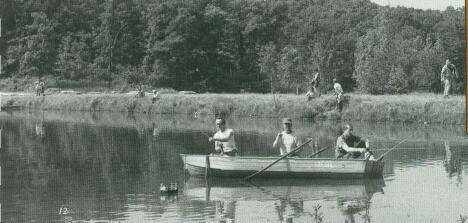
12 OutdoorIllinois
1980—1999
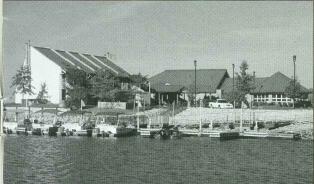
During the administration of Gov. James R. Thompson (1977-91), the Department embarked on an ambitious state park lodge building and expansion program using "Build Illinois" funds. New lodges were built at Wayne Fitzgerrell State Park on Rend Lake (left) and Eagle Creek State Park on Lake Shelbyville. Duplex cabins were built at Cave-in-Rock State Park on the Ohio River. "Build Illinois" funds also financed the construction of two full-service marinas — Golconda Marina on the Ohio River and North Point Marina, the largest marina on the Great Lakes. The Department continues to expand its lodging system, building lakefront cottages at Eldon Hazlet State Park on Carlyle Lake, and planning a new lodge at South Shore State Park on Carlyle Lake. Campground cabins, which are separate from the lodging system, also have been constructed at 14 parks around the state.
|
Lodge Facts
State parks with lodging: Nine. Lodges with cabins: six.
Oldest lodge: Starved Rock Lodge & Conference Center, Utica
Newest lodge: Carlylc Lakefront Cottages.
Biggest lodge: Eagle Creek Resort, Lake Shelbyville.
Smallest lodge: Cave-in-Rock Lodge, Cave-in-Rock State Park.
Number of guests at all lodges in 1998: 269,550.
Lodge with most guests in 1998: Starved Rock Lodge (52,947 adults and 9,206 children).
Lodges with swimming pools: six.
Lodges with conference facilities: seven.
Lodges with golf courses: three.
Lodges with tennis courts: four.
Lodges with gift shops: seven.
Lodges with restaurants: eight.
• Giant City Lodge is famous for its family-style fried chicken dinner.
• Rend Lake Resort and Conference Center is the only lodge where you can fish right off your balcony or deck.
• White Pines Inn features much of the original construction work from the 1930s.
• Pere Marquette Lodge features a life-sized chessboard in its great room.
|
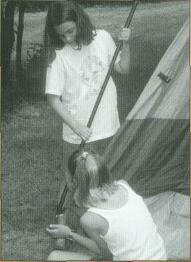
DNR's Division of Education, established in 1995 as a result of recommendations from the first two conservation congresses, allows the agency to reach people in all age groups, with an emphasis on children. "Under Illinois Skies" (above), a 1999 initiative in cooperation with the Chicago Park District, gave 72 inner-city children the opportunity to learn about pitching a tent, canoeing, fishing, identifying trees, cooking outdoors and picking out constellations in the night sky during camping trips at Kankakee River State Park.
|
Education Efforts
Safety Education Program: 1,500 volunteers have conducted 550-plus boating, hunting, snowmobile and trapping safety courses for more than 17,000 students.
KIDS FOR CONSERVATION: More than 110,000 households with children ages 5-13 receive the biannual magazine of this at-home conservation club.
Interpretive Programs: 24 state park interpreters have provided some 40,000 children with 1,000-plus programs, on-site and in schools, and have conducted programs at state park visitor centers for a quarter-million people.
Education kits: Education kits containing videotapes, audio tapes, lesson plans, activities and posters on mammals, trees, birds, aquatic resources and resource conservation have been produced and distributed free of charge to all public and private schools registered with the State Board of Education.
Teaching the Teachers: Workshops are conducted for teachers of students in grades K-12 to familiarize them with the national Project WILD, Project WILD Aquatic, Project Learning Tree and Project WET environmental education programs.
Grant programs: Schoolyard Habitat Action Grants totaling $42,000 have funded 116 projects.
Programs for Women: The Becoming an Outdoors Woman program for women over age 18 was first offered in 1994 in Illinois. Since then, 570 participants have learned to camp, shoot, fish and canoe at these twice-yearly events.
|
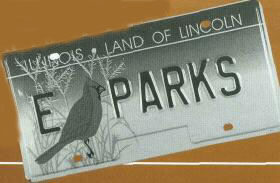
|
Illinois' environmental "E-plate, "featuring the cardinal and big bluestem, the state bird and prairie grass, was the first permanent license plate issued to raise funds in Illinois. Since 1994, the sale of more
than 8 3,000 E-plates has raised in excess of $7 million for the State Park Fund. The E-plate was a recommendation of the 1993 Conservation Congress.
|
December 1999 13
1980—1999
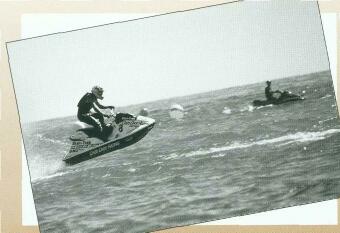
Pleasure boating was mainly the province of the rich when the 20th century began. The introduction of new, cheaper boat-building materials after World War II enabled the middle class to climb aboard a recreational boating boom that continues unabated today. In 1980, 262,855 boats were registered in Illinois. Today that number stands at 398,047. Personal watercraft, commonly called jet skis, were introduced in the late 1970s and quickly became ubiquitous on the state's waters. In 1981, only 79 PWCs were registered. Since then, the number has mushroomed to 10,939.
|
Conservation Congress
What is it? A process developed in 1993 to enable the Department to make decisions that more accurately reflect the needs and interests of its diverse constituency. Recommendations from the three congresses held to date have contributed to the Department's improved stewardship of our natural resources. Facts: 92 recommendations approved, vast majority implemented. Next Conservation Congress: Sept. 8-10, 2000, at Springfield. Organizations credentialed for next Congress: 254, representing nearly 1 million individuals.
Recommendations: An exhaustive review of recommendations is conducted by the Department. Responses are published in a report that is circulated to the director, governor and members of the Illinois General Assembly. The Department may not agree with certain recommendations and will cite reasons in the report. Constituents use the report as a guide to develop further information and sponsor viable recommendations for the next Conservation Congress.
|
Fishing Facts 1998-1999
Licensed anglers: 1.2 million.
Days spent fishing: 33.5 million.
Economic impact of fishing: $3.4 billion.
Fishable waters in Illinois: Lake Michigan, 1 million acres; three reservoirs, 55,000 acres; impoundments, 90,600 totaling 262,500 acres; rivers and streams, 26,443 miles totaling 325,000 acres.
Waters stocked with fish: 169 state-owned impoundments (35,862 acres); 283 other public impoundments (36,307 acres); 574 private and organizational waters (1,499 acres); three reservoirs; 18 streams and rivers: the Illinois portion of Lake Michigan.
Fish stocked into Illinois waters: 69.5 million, representing 24 species.
Fish produced by DNR hatcheries: 67.4 million, involving 19 species.
State fish hatcheries: Jake Wolf, Little Grassy, Spring Grove and LaSalle.
Urban Fishing Program sites: 34.
Fishing clinics conducted: 1.550.
Clinic participants: 34,098.
Aquatic Outreach Program participants: 36,473.
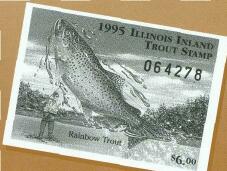
The $6 inland trout stamp was part of a "Fish Illinois" initiative passed by the General Assembly in 1993. That initiative promised more fish for stocking, expanded urban fishing programs, catchable-sized rainbow trout stockings in lakes and stream statewide, more conservation police officers, expanded fisheries management on rivers and streams, and the hiring of aquatic education specialists to develop materials for classroom use.
|
|
Sightings of
river otters have occurred in 84 of Illinois' 102 counties
since the Department first began its otter
restoration program by releasing 50 of the animals in the Little
Washbash River in 1994. Nearly 350 of the Lousiana transplants splashed into Illinois waters by the time the project ended in 1997. Protected from hunting and trapping since 1929, there were fewer than 100 otters by the early 1980s. Listed as a state endangered species in 1989, the Illinois Endangered Species Protection Board changed the otter's status from endangered to threatened earlier this year. The project had many partners, including the Illinois Conservation Foundation.
|
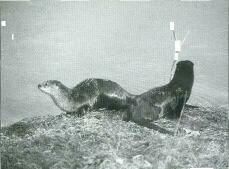
|
14 OutdoorIllinois
1980—1999
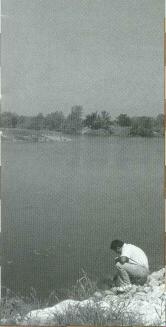
The State of Illinois has been active in acquiring property for outdoor recreation and in restoring lands such as the Sunspot Mine in Pulton County (left) that had been degraded due to mining or other commercial ventures. Examples of new acquisitions in the past few years include Site M in Cass County, Mazonia State Fish and Wildlife Area and Sahara Woods State Fish and Wildlife Area. The latter two were former mines reclaimed by DNR's Abandoned Mined Lands Reclamation Division, which has restored more than 7,800 acres of mined lands since 1977. AML is part of the Office of Mines and Minerals, which was merged with the Department of Conservation in 1995 to create the Department of Natural Resources. Other state agencies involved in the consolidation included the Water Resources Division of the Department of Transportation, and from the dissolved Department of Energy and Natural Resources: the Illinois State Museum, the Illinois Natural History, Geological and Water surveys, the Office of Research and Planning and the Waste Management and Research Center.
Conservation Foundation At A Glance
Established: 1994.
Funds raised to date: $6,126,777.
Funds for otter program: $26,800 (67 otters).
Tree seedlings program: $1.2 million from Illinois Power Company has resulted in the Division of Forestry producing an additional 5,677,500 seedlings.
Land acquisitions: 10 acres for an addition to Red Wing Slough in Lake County; 960 acres in JoDaviess County; 175 acres in Effingham County.
Capital improvement projects: A fish rearing pond at Newton Lake State Fish and Wildlife Area; construction of an environmental wetland education area at Sam Dale Lake State Park;
projects at Clinton Lake State Recreation Area.
Equipment purchases: All-terrain vehicles used by the DNR wildlife staff; a trailer and tent for the Hunter Interactive Training Program; equipment and facilities for the Conservation Police Search and Rescue Squad at Starved Rock State Park.
Youth programs funded: Fishing Outreach Program in the LaSalle County area; the Youth Goose Hunt; the 1997 and 1998 Youth Natural Resource Camp at Carlyle Lake; the first Youth Bass Tournament for under-privileged youth; Kids For Conservation.
Other projects funded: Sportsmen Against Hunger program; fish stocking in the Hennepin Canal; the Port Massac Encampment; a DNR study of possible elk reintroduction in Illinois;
the Project Wild grant program; tree plantings;
the Quincy Boat Station Project; and the Frank C. Bellrose Waterfowl Research Center of the Illinois Natural History Survey.
|
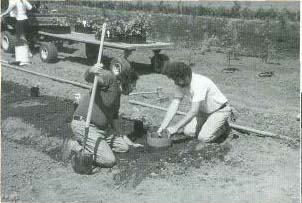
|
DNR has operated nurseries in Mason and Union counties since the early 1930s. In 1932, 12,200 tree and shrub seedlings representing 15 to 20 native and nonnative species were produced for planting on public and private lands. By last year, that number had soared to 6.9 million strictly native plants representing more than 200 species. The nurseries added prairie plants in the 1970s and wetlands plants in the 1990s—both of which are used for public land projects. The species produced by the nurseries include 59 native trees and shrubs, 56 prairie forbs, nine warm-season grasses, 21 woodland understory trees and shrubs and 76 wetland plants.
|
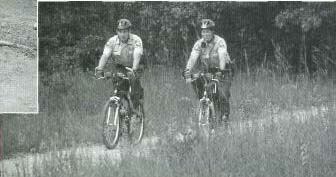
|
In 1903 there were 19 game wardens. Today, the DNR Office of Law Enforcement is a diverse group of more than 140 CPOs empowered to enforce all state laws, and as such, they undergo rigorous training at the State Police Academy. Fourteen new officers are currently at the academy, with another 36 to be hired on Jan. 1. Training continues after the academy as well. Some are trained for bicycle patrols, as firearms safety instructors, as CPR and First Responder trainers, as DUI and OUI enforcement specialists or in interviewing and interrogation techniques.
|
December 1999 15
|








